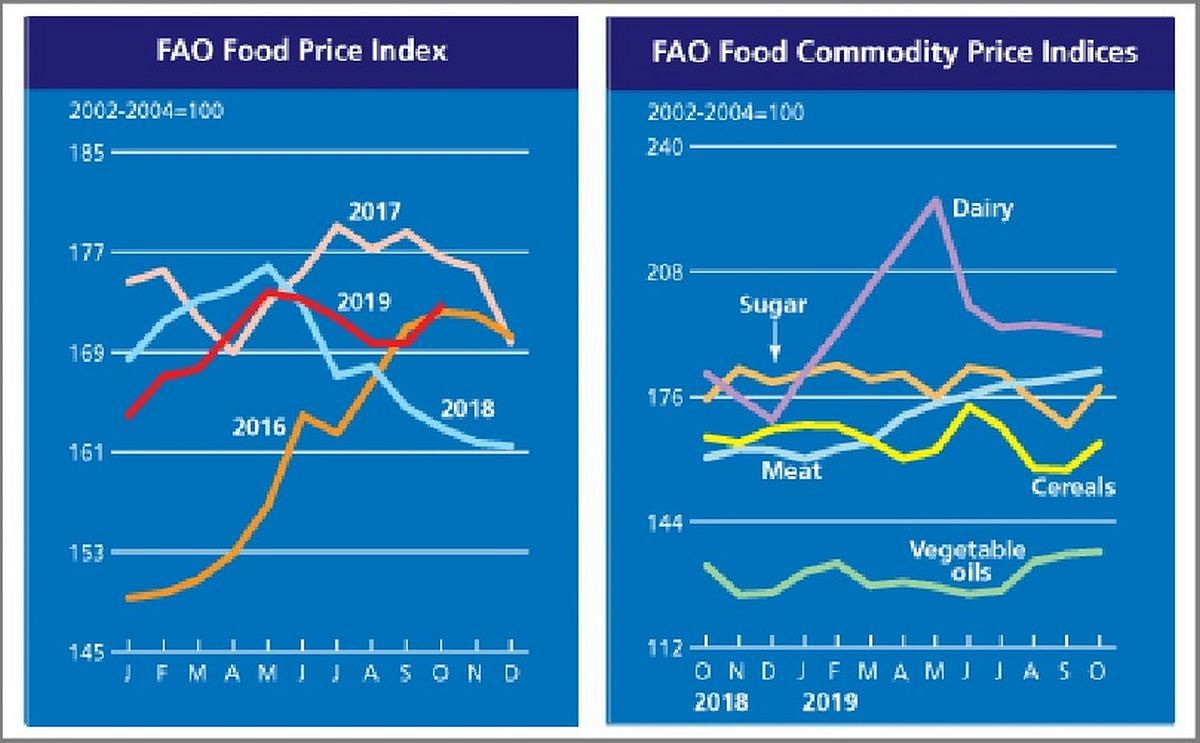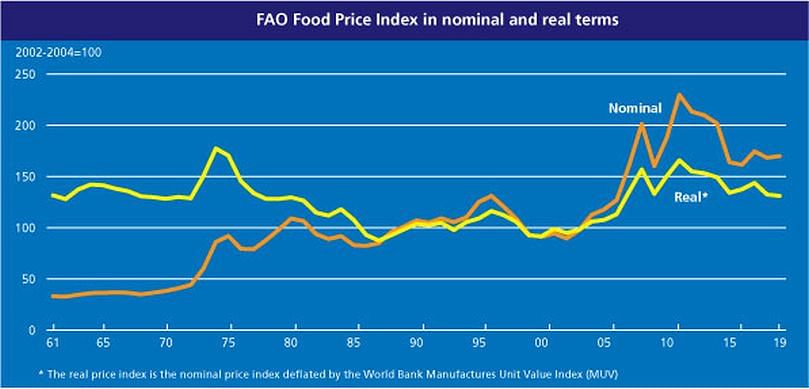October registered the first monthly increase in the value of the FAO Food Price Index since May 2019.
October registered the first monthly increase in the value of the FAO Food Price Index since May 2019

The FAO Food Price Index* ((FFPI) averaged 172.7 points in October 2019, up 1.7 percent (3 points) from September and 6.0 percent higher than in the corresponding period last year.
The increase in October marked the first significant month-on-month rise in the value of the Index since May 2019, as surges in the prices of sugar, cereals and, to a lesser extent, meat and vegetable oils, more than offset a small decline in the value of the dairy sub-index.
The FAO Cereal Price Index averaged 164.0 points in October, up by 4.2 percent (nearly 7 points) from September but still 1.0 percent below its October 2018 level.
International wheat prices moved up sharply in October largely on robust trade activities and lower crop prospects in Argentina and Australia.
Among major coarse grains, maize export prices also surged in October from very low levels in September, reflecting not only reduced crops in the United States and worries over planting conditions in Argentina, but also a pick-up in export sales.
By contrast, FAO's rice price index subsided in October, driven by declines in fragrant rice quotations prompted by low demand and prospects of an abundant basmati harvest.
The FAO Vegetable Oil Price Index averaged 136.4 points in October, up 0.5 percent (or 0.7 points) from the previous month and marking the highest level since September 2018.
The small month-on-month increase mainly reflects higher palm oil price quotations, which more than offset lower values for sunflower and rapeseed oils. International palm oil prices rose for the third consecutive month, fuelled by firm global import demand and expectations of an output slowdown in leading producing countries, as well as news of higher biodiesel mandates in Indonesia next year.
By contrast, sunflower oil price quotations fell on active farmer selling in the wake of bumper sunflowerseed harvests in the Black Sea region, while higher than expected rapeseed crushing in the EU weighed on rapeseed oil prices.
The FAO Dairy Price Index averaged almost 192 points in October, down 0.7 percent (1.4 points) from the previous month, representing the second consecutive month of decline but still 5.6 percent above its level in the corresponding month last year.
The October decline was the result of notably lower quotations for cheese, more than offsetting increases in those for Skim Milk Powder (SMP) and Whole Milk Powder (WMP).
Increased export availabilities in New Zealand were the principal factor behind the latest decline in cheese price quotations.
By contrast, strong import demand, especially from Asia for short-term deliveries, underpinned the price increases of SMP and WMP. After four months of continuous decline, butter prices began to stabilize, reflecting renewed import interests.
The FAO Meat Price Index* averaged 182.7 points in October, up 0.9 percent (1.7 points) from September, representing the ninth consecutive monthly increase. International price quotations for bovine and ovine meats continued to rise, with buoyant import demand, especially from China, providing support.
Quotations for pig meat also increased, albeit moderately, reflecting continued import demand in Asia despite seasonally increasing supplies from Europe and higher export availabilities in Brazil.
Prices of poultry meat fell under downward pressure due to increased export availabilities in main producing regions.
The FAO Sugar Price Index averaged 178.3 points in October, up 5.8 percent (9.8 points) from its reduced September average. The sharp rebound in international sugar prices in October was mainly underpinned by expectation of much tighter supply prospects in 2019/20.
Latest indications point to a significant contraction in sugar output in India, the world’s largest sugar producer, mainly because of a 10 percent reduction in sugarcane planted area compared to the previous season.
Likewise, sugar output in Thailand, the world’s second largest sugar exporter, is seen lower by 7 percent from last year as a result of protracted dry conditions.
Still, sugar prices remained volatile, influenced by swings in crude oil prices, changing weather conditions in India, and movements in the Brazilian Real against the United States Dollar.












